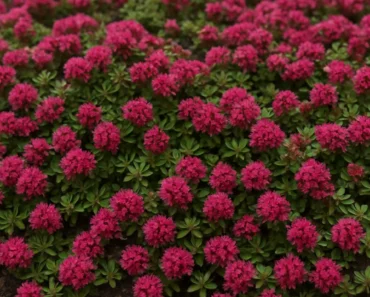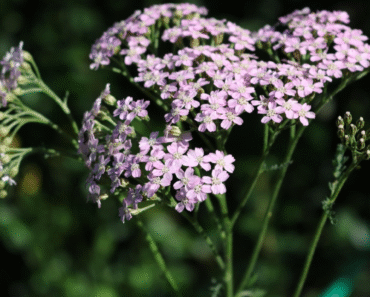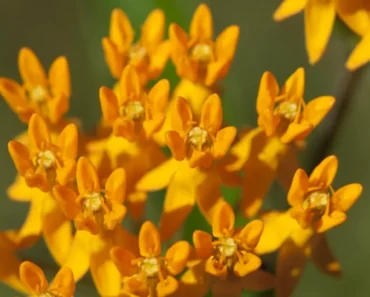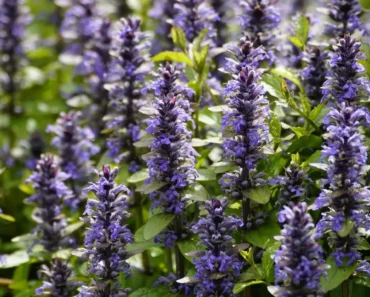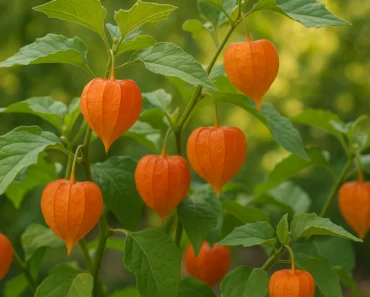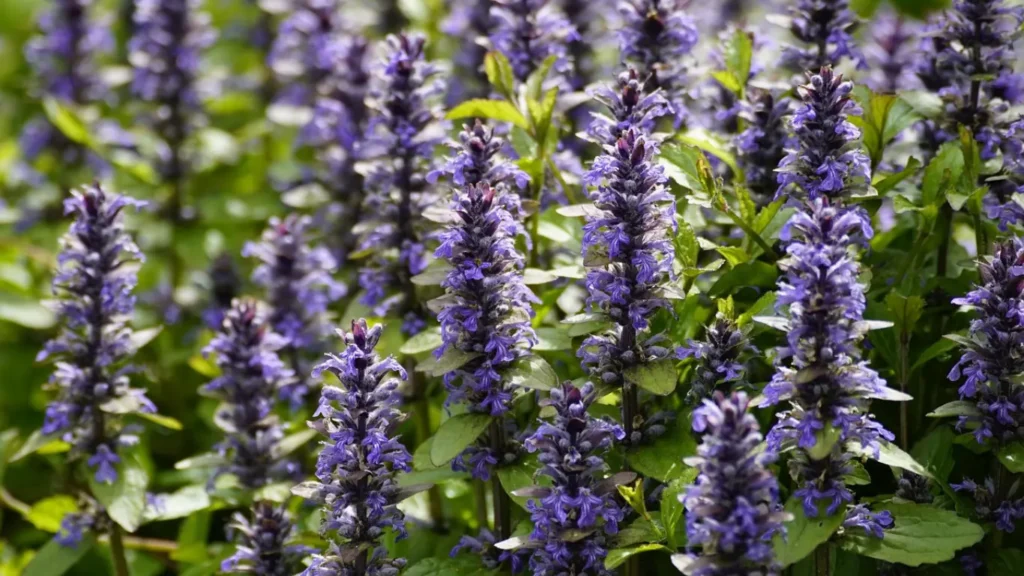
Bugleweed (Ajuga reptans) is a popular perennial known for its vibrant foliage and stunning blue-violet flowers. It’s commonly used as ground cover, providing both aesthetic appeal and practical benefits like erosion control and weed suppression. In this guide, we will dive into the essential information about bugleweed, from its botanical profile to care instructions, varieties, and troubleshooting common issues.
Table of Contents
Understanding Bugleweed and Its Benefits
Bugleweed, also known as Ajuga reptans, belongs to the Lamiaceae (mint) family and is native to parts of Europe, Asia, and North Africa. It is prized for its ability to thrive in shady areas, making it an ideal choice for garden beds that lack direct sunlight. Bugleweed is a low-maintenance, hardy plant that can spread quickly and form dense mats, making it perfect for ground cover in shaded or woodland gardens.
- Scientific Classification:
- Genus: Ajuga
- Species: reptans
- Family: Lamiaceae (Mint family)
- Hardiness Zones: 3-10 (USDA), meaning it can tolerate a wide range of temperatures, from cold winters to mild summers.
- Common Uses: Bugleweed is primarily used as ground cover, for erosion control, and in shady garden areas. For a deeper look into bugleweed and its uses, check out Garden Design’s guide on Ajuga.
Popular Bugleweed Varieties
There are several varieties of bugleweed, each offering unique characteristics. The most common varieties include:
- Common Ajuga reptans:
- Description: This variety features glossy green leaves and spikes of blue-violet flowers, making it a great choice for ground cover.
- Care: Prefers moist, well-drained soil and partial to full shade. It can spread quickly, forming a dense mat.
- ‘Chocolate Chip’:
- Description: Known for its compact size, this variety has small, bronze-colored foliage, making it perfect for edging or container planting.
- Care: Grows well in both sun and shade but thrives in shaded areas with moist, well-drained soil.
- ‘Black Scallop’:
- Description: A more dramatic variety with dark purple-black leaves and striking blue flower spikes.
- Care: Needs well-drained, slightly acidic soil and moderate watering. Ideal for shady areas.
- ‘Caitlin’s Giant’:
- Description: Larger leaves and flowers compared to other varieties, offering more robust growth.
- Care: Performs well in full or partial shade, and it is excellent for areas where more ground coverage is needed.
For more information on different varieties of bugleweed and how to care for them, check out North Carolina Extension Gardener’s Plant Toolbox.
Ideal Growing Conditions for Bugleweed
Bugleweed thrives in specific growing conditions that cater to its native environment. Here’s how you can create the perfect environment for your bugleweed:
- Light Requirements:
- Partial to Full Shade: While bugleweed can tolerate some sunlight, it performs best in shaded or woodland garden settings. Too much sun can scorch the leaves, especially in hot climates.
- Full Sun: Some varieties, such as Chocolate Chip, can tolerate more sun but still need some afternoon shade to prevent leaf burn.
- Soil Preferences:
- Well-draining Soil: Bugleweed prefers moist but well-drained soil. Ensure the soil does not stay waterlogged, as this can cause root rot.
- pH Levels: Slightly acidic to neutral pH is ideal for optimal growth.
- Watering Needs:
- Moderate Watering: Water regularly, especially during dry spells, but make sure the soil is not overly saturated. Overwatering can lead to fungal diseases.
- Mulching: Apply a layer of mulch to retain moisture and suppress weeds. Organic mulches like wood chips or bark work well.
For detailed care instructions and more tips, refer to Almanac’s guide on bugleweed.
Planting and Maintenance of Bugleweed
Planting and maintaining bugleweed requires minimal effort. Here are the key steps to ensure healthy growth:
- Planting:
- Spacing: Space plants 6–12 inches apart to allow for adequate growth. Bugleweed spreads via runners and forms dense mats over time.
- Depth: Plant at the same depth as the nursery pot. If transplanting from a container, gently loosen the roots before planting.
- Mulching:
- Benefits: Helps retain moisture in the soil and suppresses weeds, which can compete with bugleweed for nutrients.
- Material: Use organic mulch, such as bark or compost, for best results.
- Fertilization:
- Type: Use a balanced, slow-release fertilizer. Bugleweed doesn’t require heavy feeding, but it will benefit from occasional fertilizing during the growing season.
- Schedule: Apply fertilizer in early spring to promote healthy growth.
- Pruning and Deadheading:
- Deadheading: Remove spent flowers to encourage a longer blooming season.
- Trimming: Trim back leggy or damaged growth after flowering to maintain a tidy appearance.
For a more detailed planting and maintenance guide, refer to Gardener’s World’s bugleweed care instructions.
Medicinal Uses of Bugleweed
Though bugleweed is primarily used as an ornamental plant, certain species, such as Lycopus europaeus, have been used in traditional medicine for their purported medicinal properties. Here are some of the known medicinal uses of bugleweed:
- Hyperthyroidism Treatment:
- Effect: Known for its ability to reduce thyroid hormone production, bugleweed has been traditionally used to treat hyperthyroidism.
- Form: It is commonly consumed as a tea or tincture.
- Traditional Applications:
- Symptoms Treated: Used in the treatment of palpitations, anxiety, and insomnia due to its calming effect on the heart.
- Preparation: Can be brewed into teas or taken as extracts.
While bugleweed has historical significance in herbal medicine, it is important to consult with a healthcare provider before using it for medicinal purposes, especially since its effects are still being researched.
For more on the medicinal uses of bugleweed, check out Verywell Health’s article on bugleweed.
Troubleshooting Common Bugleweed Problems
While bugleweed is relatively low-maintenance, it can encounter some issues, especially if the growing conditions are not ideal. Here’s how to troubleshoot common problems:
- Invasive Growth:
- Problem: Bugleweed can spread quickly and become invasive in some gardens.
- Solution: Trim back the plants regularly and contain growth with edging or barriers to prevent it from overtaking other plants.
- Yellowing Leaves:
- Cause: Bugleweed may develop yellow leaves due to overwatering, a lack of nutrients, or pest infestations.
- Fix: Adjust your watering schedule, check for pests, and apply a balanced fertilizer if needed.
- Poor Flowering:
- Cause: Insufficient light or overcrowding can prevent bugleweed from blooming as expected.
- Solution: Ensure your bugleweed receives enough indirect light and that the plants are spaced correctly.
- Pest Infestations:
- Problem: Aphids, slugs, and snails are common pests that may attack bugleweed.
- Solution: Use organic pesticides or natural predators like ladybugs to control aphids, and set up barriers to protect the plants from slugs and snails.
Frequently Asked Questions about Bugleweed
- Q1: Is bugleweed deer-resistant?
- A1: Yes, bugleweed is typically resistant to deer and rabbits.
- Q2: Can I grow bugleweed in containers?
- A2: Yes, bugleweed is well-suited to container gardening and can be grown in hanging baskets or pots.
- Q3: How quickly does bugleweed spread?
- A3: Bugleweed spreads rapidly via runners and can form dense mats in a short time.
- Q4: What is the ideal pH level for bugleweed?
- A4: Bugleweed prefers slightly acidic to neutral soil (pH 6.0–7.0).
- Q5: Does bugleweed attract pollinators?
- A5: Yes, bugleweed attracts bees and butterflies, making it a valuable addition to pollinator-friendly gardens.
Conclusion: Why You Should Add Bugleweed to Your Garden
Bugleweed is a versatile and hardy plant that adds color, texture, and functionality to any garden. Whether you’re using it for ground cover, erosion control, or as an ornamental feature, bugleweed is an excellent choice. With proper care and maintenance, it will thrive in a variety of conditions, providing beauty and practicality year-round.
Author
George Wine is a seasoned gardening expert with over 20 years of experience in the field of horticulture. His passion for plants and nature has driven his career, where he has honed his skills in various aspects of gardening, from landscape design to plant care. George holds a Master of Science in Horticulture from the University of California, Davis (UC Davis), a prestigious institution known for its research and advancements in plant science.
Throughout his career, George has worked with a diverse range of clients, offering tailored solutions to enhance outdoor spaces and create thriving gardens. His knowledge and expertise allow him to provide invaluable advice, ensuring that both novice and experienced gardeners achieve their gardening goals. Whether you’re looking for tips on sustainable gardening practices, innovative design ideas, or advice on specific plant species, George is here to help you cultivate the garden of your dreams.


